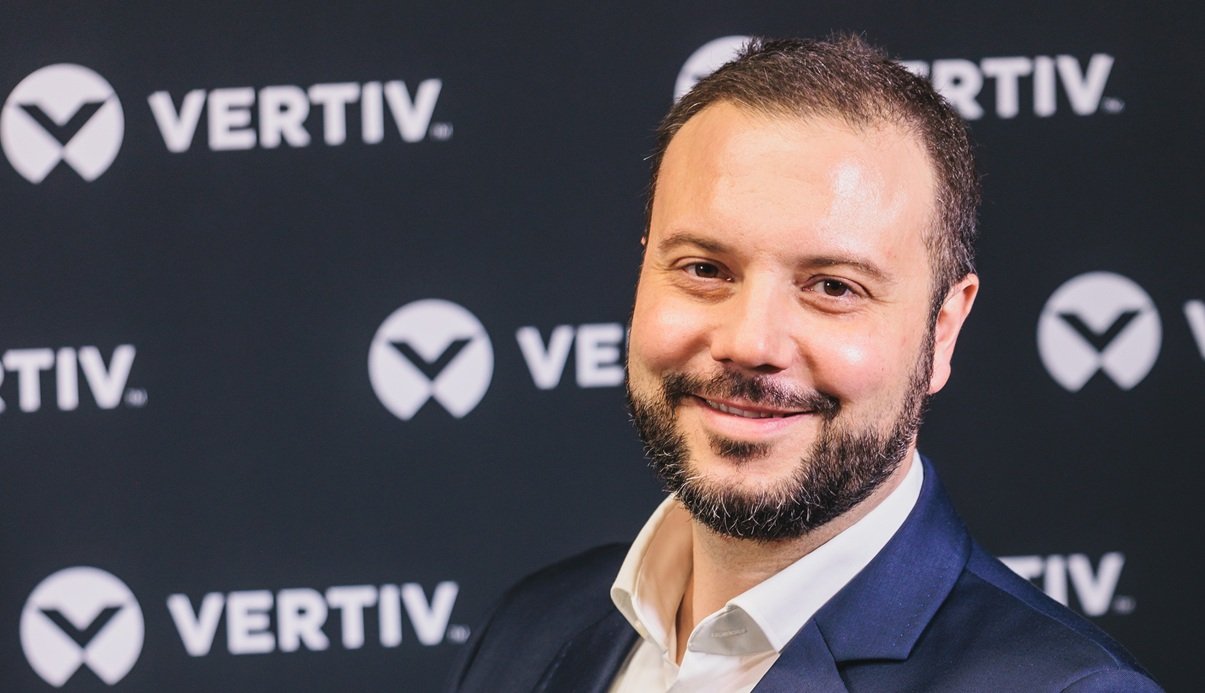 Vedran Brzić, Vice President for Infrastructure Solutions EMEA at Vertiv, explains how Vertiv is transforming data center deployment across the Middle East and Africa with modular, sustainable, and AI-ready infrastructure solutions that address regional challenges and drive scalable, energy-efficient, and rapid digital transformation.
Vedran Brzić, Vice President for Infrastructure Solutions EMEA at Vertiv, explains how Vertiv is transforming data center deployment across the Middle East and Africa with modular, sustainable, and AI-ready infrastructure solutions that address regional challenges and drive scalable, energy-efficient, and rapid digital transformation.
How do you see the modular data center market evolving globally and in the Middle East over the next few years, and what factors are driving this accelerated adoption?
Globally, prefab modular data centers are evolving from a niche option into a mainstream strategy for deploying scalable critical digital infrastructure, driven by the accelerating adoption of AI and the need for greater agility to support fast-changing workloads.
In the Middle East, this evolution is even more pronounced. The region’s rapid technological growth, challenging environmental conditions, and growing emphasis on local technical expertise have created an ideal environment for modular, prefabricated solutions. Their appeal lies in the ability to deliver speed-to-market, energy efficiency, and standardized, scalable architectures that enable consistency and flexibility across deployments.
The demand for more sustainable data centers is also rising sharply across the MEA region, with modular designs supporting this shift through their focus on efficiency and environmental responsibility. This growing focus on sustainability reflects a broader regional trend toward responsible business and operational resilience.
Furthermore, governments across the Middle East are playing a crucial role in driving this momentum by offering land, power access, and tax incentives to data center operators—initiatives that are fostering a strong investment climate and supporting both modernization of existing infrastructure and the development of new, AI-ready facilities. Together, these factors position prefab modular data centers as a cornerstone of the region’s digital transformation over the coming years.
How is Vertiv innovating within the modular data center space to meet growing demands for scalability, energy efficiency, and rapid deployment?
Vertiv is redefining how data centers are built and deployed by moving from traditional, bespoke, site-built facilities toward modular and hybrid prefabricated infrastructure solutions. This shift enables customers to accelerate deployment timelines while providing flexibility and scalability to meet the demands of emerging AI and high-performance computing (HPC) workloads. By leveraging standardized, factory-integrated modules, Vertiv helps operators reduce construction complexity and bring capacity online faster—an essential capability in a market where speed-to-market is critical.
A prime example of this innovation is Vertiv OneCore, the company’s flagship modular platform. Designed to support very high-density deployments of 5+ MW as well as mixed workloads, Vertiv OneCore provides highly configurable and scalable architecture. Its modular design minimizes on-site work, shortens commissioning times, and allows operators to replicate proven designs across multiple sites. This approach provides a balance between standardization and customization, giving customers the flexibility to adapt the critical digital infrastructure as their computing requirements evolve.
Beyond physical infrastructure, Vertiv’s modular solutions integrate advanced digital controls and telemetry to transform the data center into an intelligent, operational platform. These capabilities enable real-time monitoring, efficient orchestration, and predictable performance across regions—turning data center infrastructure into a dynamic system that supports both operational excellence and long-term efficiency. By combining modular design with digital intelligence, Vertiv is not only accelerating deployment but also enabling the next generation of reliable, scalable, and AI-ready data centers.
With sustainability now a critical business priority, how is Vertiv integrating green design and energy-efficient technologies into its modular data center solutions?
Sustainability has become a defining principle in data center design. Through modular construction, Vertiv enables factory pre-assembly and testing, an approach that minimizes material waste, reduces on-site energy use, and eliminates many inefficiencies associated with traditional builds. This controlled, standardized process provides higher quality and a lower environmental footprint, while also accelerating deployment timelines.
Solutions such as Vertiv OneCore demonstrate how high-density, scalable critical digital infrastructure can coexist with responsible energy management. The platform’s design supports optimized power and cooling efficiency, helping customers operate more effectively as they scale AI and HPC workloads. By improving system utilization and energy performance, Vertiv empowers operators to make measurable progress toward their energy efficiency goals.
Beyond modular design, Vertiv is advancing responsible data center technologies through innovations such as liquid cooling, advanced power distribution systems, and the integration of alternative materials like mass timber—exemplified in the Vertiv™ TimberMod concept. Together, these developments reflect Vertiv’s contribution to helping customers balance digital growth with environmental responsibility, enabling the next generation of efficient, intelligent, and future-ready data centers.
How are emerging technologies such as AI, 5G, and edge computing influencing modular data center design and deployment strategies?
Technologies such as AI, 5G, and edge computing are fundamentally reshaping the way data centers are designed and deployed. AI and high-performance computing workloads drive very high-density power requirements and advanced cooling needs. These are the key challenges that modular platforms are specifically engineered to address. By supporting these demanding workloads, modular solutions enable operators to scale efficiently while maintaining reliability and performance.
Modular prefabricated solutions are particularly well-suited to the rapid deployment of distributed and edge computing infrastructures, meeting the growing demand for flexible, repeatable designs that can be deployed quickly across multiple sites. Configurable modules with integrated monitoring and controls allow operators to respond dynamically to evolving compute requirements, enabling operational efficiency, predictable performance, and low-latency operation at key digital hubs. By combining speed, standardization, and reliability through pre-engineered, factory-tested modules, prefab solutions provide the resilience and scalability necessary to support emerging workloads in a rapidly evolving digital landscape.
What unique opportunities and challenges does Vertiv see in the Middle East and Africa for modular data centers, and how is the company positioning itself to address them?
The Middle East and Africa present both unique opportunities and distinct challenges for prefabricated modular data centers. One key consideration is the region’s diverse and often harsh climate, which directly impacts cooling strategies. In extremely hot environments, solutions such as chilled water systems are critical for increasing free-cooling capacity, improving energy efficiency, and optimizing resource usage.
Unlike regions with milder conditions where some European clients can leverage seasonal drops in air and water temperature to manage thermal loads, our approach in the Middle East and Africa involves rigorous testing to verify that equipment remains reliable and resilient under extreme temperatures and environmental stresses. By understanding these local conditions and tailoring modular designs accordingly, Vertiv is able to deliver robust, scalable, and high-performance infrastructure solutions that meet the growing digital demands of the region.

